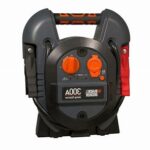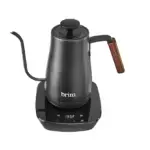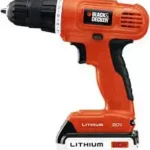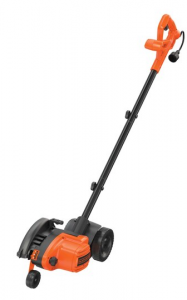

BLACK+DECKER LE750 EdgeHOG 2-in-1 Landscape Edger
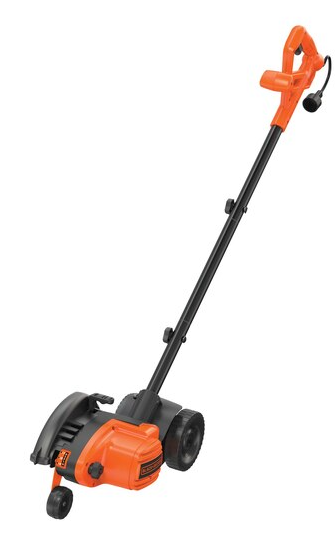
BLACKandDECKER LE750 EdgeHOG 2-in-1 Landscape Edger
Instruction
LE750 TYPE 2 & 3
BEFORE RETURNING THIS PRODUCT
FOR ANY REASON PLEASE CALL
1-800-54-HOW-TO (544-6986)
IF YOU SHOULD EXPERIENCE A PROBLEM WITH YOUR BLACK & DECKER PRODUCT, CALL 1-800-54-HOW-TO (544-6986).
BEFORE YOU CALL, HAVE THE FOLLOWING INFORMATION AVAILABLE, CATALOG NO., TYPE NO. AND DATE CODE. IN MOST CASES, A BLACK & DECKER REPRESENTATIVE CAN RESOLVE YOUR PROBLEM OVER THE PHONE. IF YOU HAVE A SUGGESTION OR COMMENT, GIVE US A CALL.YOUR FEEDBACK IS VITAL TO THE SUCCESS OF BLACK & DECKER.
KEY INFORMATION YOU SHOULD KNOW
- Your edger is designed to eject clippings and other debris forward, away from the operator.
- Inspect and thoroughly clean your edger at the start of each edging season.
- The blade on this tool is not intended to be sharp. Do not sharpen it in any way.
- Make sure edging area (100 ft.) is clear of other persons or pets prior to starting operation.
SAVE THIS MANUAL FOR FUTURE REFERENCE
Cat No. LE750 Type 2 & 3
Copyright © 2002 Black & Decker
Form No. 243420-02 Rev. 4
SEPT. ‘02
Printed in Mexico

WARNING: Important Safety Warnings and Instructions

WARNING: When using electric gardening appliances, basic safety precautions should always be followed to reduce risk of fire, electric shock, and personal injury, including the following.

WARNING: Some dust created by this product contains chemicals known to the State of California to cause cancer, birth defects or other reproductive harm. Some examples of these chemicals are:
- compounds in fertilizers
- compounds in insecticides, herbicides and pesticides
- arsenic and chromium from chemically treated lumber
To reduce your exposure to these chemicals, wear approved safety equipment such as dust masks that are specially designed to filter out microscopic particles.

WARNING: This product contains chemicals, including lead, known to the State of California to cause cancer, and birth defects or other reproductive harm. Wash hands after handling.

CAUTION: Wear appropriate personal hearing protection during use. Under some conditions and duration of use, noise from this product may contribute to hearing loss.
READ ALL INSTRUCTIONS
TO REDUCE RISK OF INJURY:
- Before any use, be sure everyone using this tool reads and understands all safety instructions and other information contained in this manual.
- Save these instructions and review frequently prior to use and in instructing others.

GENERAL SAFETY WARNINGS AND INSTRUCTIONS FOR ALL TOOLS

SAFETY WARNINGS AND INSTRUCTIONS: DOUBLE INSULATION
REPLACEMENT PARTS: When servicing use only identical Black & Decker replacement parts.

IMPORTANT SAFETY INSTRUCTIONS: POLARIZED PLUGS
To reduce the risk of electric shock, this equipment has a polarized plug (one blade is wider than the other). This equipment must be used with a suitable polarized 2 wire or 3 wire extension cord. Polarized connections will fit together only one way. Make sure that the receptacle end of the extension cord has large and small blade slot widths. If the plug does not fit fully into the extension cord, reverse the plug. If it still does not fit, obtain a suitable extension cord. If the extension cord does not fit fully into the outlet, contact a qualified electrician to install the proper outlet. Do not modify the appliance plug or extension cord in any way.
THIS TOOL CAN BE DANGEROUS. Follow all warnings and Safety Instructions in this manual. The operator is responsible for following warnings and instructions in this manual and on unit. Restrict use of this power tool to persons who read, understand and follow warnings and instructions in this manual and on unit.
- AVOID DANGEROUS ENVIRONMENT. Don’t use appliances in damp or wet locations. Don’t use appliances in the rain.
- KEEP CHILDREN AWAY. All other persons and pets should be kept at a safe distance from work area.
- STORE IDLE APPLIANCES INDOORS. Appliances should be stored indoors in dry, secured area – out of reach of children.
- DON’T FORCE APPLIANCE. It will do the job better and with less likelihood of a risk of injury at the rate for which it was designed.
- USE RIGHT APPLIANCE. Do not use the appliance for any job except that for which it is intended.
- DRESS PROPERLY. Do not wear loose clothing or jewelry. They can be caught in moving parts. Rubber gloves, long pants and substantial, non-skid footwear are recommended when working outdoors. Do not go barefoot or wear sandals. Wear protective hair covering to contain long hair.
- USE SAFETY GLASSES AND OTHER SAFETY EQUIPMENT. Use safety goggles or safety glasses with side shields, complying with applicable safety standards and, when needed, a face shield. Also use face or dust mask if operation is dusty. This applies to all persons in the work area. Also use a hard hat, hearing protection, gloves, safety shoes and dust collection systems when specified or required. Safety glasses or the like are available at extra cost at your local dealer or Black & Decker Service Center.
- DON’T ABUSE CORD. Never carry appliance by cord or yank it to disconnect from receptacle. Keep cord from heat, oil, and sharp edges.
- DON’T OVERREACH. Keep proper footing and balance at all times.
- MAINTAIN APPLIANCE WITH CARE. Keep cutting edge clean for best performance and to reduce the risk of injury. Follow instructions for lubricating and changing accessories. Inspect appliance cord periodically and if damaged, have it repaired by authorized service facility. Inspect extension cords periodically and replace if damaged. Keep handles dry, clean, and free from oil and grease.
- DISCONNECT APPLIANCES. Disconnect the appliance from the power supply when not in use, before servicing, and when changing accessories such as blades and the like.
- AVOID UNINTENTIONAL STARTING. Don’t carry plugged-in appliance with finger on switch. Be sure switch is off when plugging in.
- EXTENSION CORDS. Make sure your extension cord is in good condition. Cord insulation must be intact with no cracks or deterioration. Plug connectors must be undamaged. When using an extension cord, be sure to use one heavy enough to carry the current your product will draw. An undersized extension cord will cause a drop in line voltage resulting in loss of power and overheating, which can shorten the life of the motor. The table shows the correct size to use depending on cord length and nameplate ampere rating. If in doubt, use the next heavier gage. The smaller the gage number, the heavier the cord. The table shows the correct size to use depending on cord length and nameplate ampere rating. If in doubt, use the next heavier gage. The smaller the gage number, the heavier the cord.
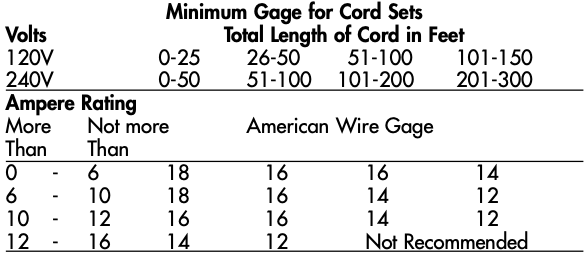

- OUTDOOR USE EXTENSION CORDS

- GROUND FAULT CIRCUIT INTERRUPTER (GFCI) protection should be provided on the circuits or outlets to be used for the gardening appliance. Receptacles are available having built in GFCI protection and may be used for this measure of safety.
- STAY ALERT. Watch what you are doing. Use common sense. Do not operate appliance when you are tired, ill or under the influence of any drugs or alcohol.
- CHECK DAMAGED PARTS. Before further use of the appliance, a guard or other part that is damaged should be carefully checked to determine that it will operate properly and perform its intended function. Check for alignment of moving parts, binding of moving parts, breakage of parts, mounting, and any other conditions that may affect its operation. A guard or other part that is damaged should be properly repaired or replaced by an authorized service center unless otherwise indicated elsewhere in this manual.
- REPAIRS AND SERVICE. Repairs, maintenance and any adjustments not specified in this manual should be performed by Black & Decker authorized service centers or other qualified service organizations, always using identical replacement parts.
- USE OF ACCESSORIES AND ATTACHMENTS. The use of any accessory or attachment not recommended for use with this appliance could be hazardous. Note: Refer to the accessory section of this manual for further details.

ADDITIONAL WARNINGS FOR EDGERS
- Keep guard in place.
- Keep blade area clean.
DANGER: Risk of injury. Keep hands and feet away from blade and cutting area.
Important Warning
When using the edger, stones, pieces of metal and other objects can be thrown out at high speed by the blade. The tool and guard are designed to reduce the danger. However, the following special precautions should be taken:
- Wear safety glasses or other eye protection, gloves, long pants and substantial footwear.
- Make sure that other persons and pets are at least 100 feet away.
- Always stand to left side of main handle.
- Before Landscaping or Trenching, check for buried electrical cables.
- To reduce the risk of rebound (ricochet) injury, work going away from any nearby solid object such as a wall, steps, large stone, tree, etc. Use great care when working close to solid objects or into the wind, and, where necessary, do edging or trimming by hand.
SAVE THESE INSTRUCTIONS
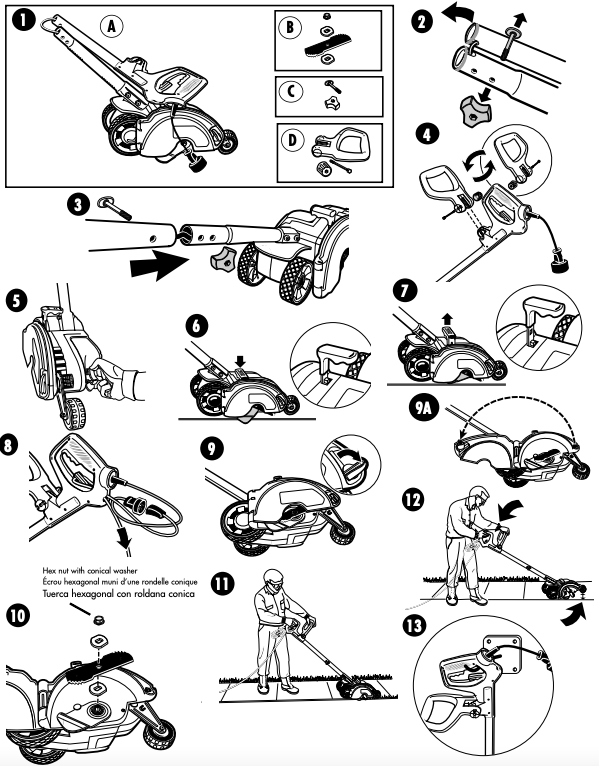
ASSEMBLY INSTRUCTIONS
BEFORE ASSEMBLING YOUR EDGER, CHECK THAT YOU HAVE RECEIVED THE FOLLOWING IN THE SHIPPING CARTON.
SEE FIGURE 1.
A. LE750 Landscape/Edger
B. Edge Hog blade with nut, conical washer and spacer system (assembled to unit)
C. Tube connecting bolt and knob (assembled to lower tube)
D. Auxiliary Handle, with bolt and knob
ASSEMBLING THE HANDLE
Assemble Handle Tubes (Figure 2 and 3)
- Remove knob and curved head bolt from lower handle tube mounting holes.
- Slide upper handle tube down into lower handle tube so that holes will line up (Figure 3). There are two positions available for adjustment to your preferred height setting. See Figure 11 for upper handle orientation.
- NOTE: Ensure the wire cable moves smoothly down into the lower handle tube while assembling.
- Fasten handle tubes together with the knob and curved head bolt. Note that when you first insert the bolt it may be necessary to wiggle it carefully to get it past the jacketed wire inside the tube.

CAUTION: NEVER use a sharp object to move jacketed wires out of the way.
Position Auxiliary Handle (Figure 4)
- Undo the knob from the bolt in the auxiliary handle and push/pull the bolt out of the handle.
- Slide the auxiliary handle onto the main handle. The auxiliary handle can be positioned for either left or right-hand operation whichever is more comfortable. The auxiliary handle is NOT adjustable forward/back.
- Insert the bolt back into the auxiliary handle hole on the side with the hex recess, attach the knob and fully tighten.
Cut Depth Adjustment (Figure 5)
The front wheel can be adjusted to allow a deeper or shallower cut, and to increase the life of the blade. Change the cut depth from the shipping position to your desired depth by:
- Wait for blade to come to complete stop!
- UNPLUG TOOL!
- Loosen the Cut Depth Knob.
- Adjust wheel depth, using the depth indicator on the wheel bracket and the marking on the front housing.
Note: Recommend 1” depth for edging. - Tighten Knob firmly.
Tip: Thick overgrowth may drag on the guard. Reduce cut depth to minimum to help reduce this effect.
Pull-Up Edge Guide (Figure 6, 7)
The edge guide is useful for cutting a straight path along sidewalks. For landscaping or trenching in the yard the edge guide can interfere with moving the edger through hard soil or sod. The edge guide can be adjusted so that the tool will also perform TRENCHING and LANDSCAPING operations.
To Change Position Of The Edge Guide
- Wait for blade to come to complete stop!
- UNPLUG TOOL!
- Pull Edge Guide Knob sideways to unlock from the guard tab, see Figure 6 detail, in direction of small arrow. Lift the knob up until the lower square notch in the lever lines up with the tab on the guard. In this position the edge guide is lifted up (Figure 7) so the tool can easily cut along the edges of flower and shrubbery beds, and around trees in preparation for trenching or sod removal.
- To return edge guide to lower position, pull lever sideways and push down until guard tab fits into upper lever hole.
Tip: You may need to tilt edger back to allow edge guide to be moved into down position.
Attaching Extension Cord To Edger (Figure 8)
Important Safety Instructions: Polarized Plugs
To reduce the risk of electric shock, this equipment has a polarized plug (one blade is wider than the other). Do not modify the appliance plug or extension cord in any way. Read IMPORTANT SAFETY INSTRUCTIONS at beginning of manual. Note: Check the extension cord safety instructions provided earlier.
- To prevent disconnection of edger cord, secure extension cord by tying the power plug as shown.
- Insert plug into cord socket.
- An extension cord retainer is built into the switch handle to reduce strain on the power cord. To use this feature, simply double the extension cord as shown, about a foot from the end, and insert it into the end of the handle. Hook the loop formed by doubling the cord over the tab. Gently tug on the cord to ensure that it is firmly retained in the handle.
- Keep extension cord clear of operator, unit, and any obstacles at all times. Do not expose the cord to heat, oil, water, or sharp edges.
Blade Guard (Figure 9 & 9A)
Wait for blade to come to complete stop!
UNPLUG TOOL!
The guard swings open for cleaning inside of blade housing or for changing blades. To open guard turn the guard release knob clockwise (facing blade guard side of tool) until it stops (a turn of about 90˚) fig. 9 detail; pull the knob to open the door (fig. 9A). When closing the guard turn the knob clockwise 90˚ (fig. 9 detail) and push the door completely closed. The knob should automatically lock the door. If the knob doesn’t return to the locked position press the door until the knob engages. BE SURE GUARD IS PROPERLY CLOSED AND KNOB IS LOCKING IT BEFORE OPERATING EDGER.
Blade (Figure 10)
Wait for blade to come to complete stop!
UNPLUG TOOL!
The blade, two spacers and hex head nut with conical washer should be attached to your edger in the order shown. Please check that the blade has been properly mounted before using your edger. The Edge Hog blade has two wear indicators that show when blade needs to be replaced. When the blade wears to the small hole at each end of the blade it will give only 1/4″ depth of cut and should be replaced.
Tip: To increase blade life, keep initial cutting depth at minimum and increase depth setting as blade wears.
TO REMOVE THE BLADE FOR REPLACEMENT:
Wait for blade to come to complete stop!
UNPLUG TOOL!

CAUTION: Blade rotates momentarily after the switch is released.
- Turn knob and open door.
- Loosen the hex head nut (9/16”). Use a 1″ wrench on the outer spacer, or a 2” x 4” wood block between the blade and guard if necessary to hold the blade from turning.
TO ATTACH NEW BLADE: - Ensure inner spacer is on shaft—”flats” in spacer hole must engage with “flats” on shaft.
- Holding the spacer in place, put the blade on the shaft, as shown (Figure 10).
- Hold the blade against the spacer and install the outer spacer, again aligning the flats in the spacer with the flats on the shaft.
- Install the hex head nut and conical washer, then tighten with a wrench (140 in.pounds).
Note: Replace hex head nut and conical washer only with identical replacement part, see Service Information. - Close door; knob must be in locking position.
Switch
To turn tool ON, squeeze the trigger switch. The trigger has been designed so that it is very easy to hold in the ON position. To turn tool OFF, release the trigger.
OPERATING INSTRUCTIONS
NOTE: The edger is a major appliance and should not be operated simultaneously with other major appliances on the same household circuit.
Warning: Make sure that other persons and pets are at least 100 feet away.
- Set cut depth at 1” and set edge guide to the down position, refer to Assembly Instructions.
- Before starting the edger, line up the tool so the edge guide rests against the edge of the paved surface (Figure 11). Both rear wheels should be on the paved surface when edging.
Tip: When there is heavy overgrowth of grass over the paved surface it may drag on the guard. An initial cut may be required with the edger on the grass side. This will require lifting up the edge guide and may require reducing the depth of cut (see Edge Guide and Depth Adjustment instructions). - To avoid kickback of edger, tilt the handle down so the blade is above the ground (Figure 12).
- Turn switch ON and allow blade to spin without moving tool.
- Slowly lift the handle to lower the blade, finding the edge of the paved surface and start edging. Then move tool forward slowly along edge of paved surface, keeping the edge guide pressed lightly against the pavement edge.
For the first edging each season, it is best to move forward slowly because grass is thickest then. Subsequent edging will be completed more rapidly. If the tool slows down, back it up an inch or two until the blade comes up to normal speed. During edging some sparks may be generated from hitting stones. This is normal. Do not attempt to edge when the grass or soil is wet or moist—for electrical safety and to prevent clogging of the blade chamber. If you must edge under conditions that cause the blade chamber to become clogged, release trigger, wait for blade to come to complete stop! UNPLUG TOOL! open door and remove clogged material with a stick. To continue to operate the tool in a clogged condition will seriously overload the motor.

CAUTION: Do not attempt to unclog the blade chamber by dropping or tapping the tool on the ground. This can damage the unit. Keep hands clear of edge guide and blade when cleaning as these wear to a very sharp point during edging.
Landscaping/Trenching
Warning: Before Landscaping or Trenching, inspect and ensure there are no exposed or buried cables, pipes or other objects that may create a hazard or interfere with operating the edger. Set depth to only that required for the job. Do not overload. If tool slows, pull back slightly and wait until blade comes up to normal speed.
Storage
Warning! Be sure the tool is unplugged.
Remove and clean any debris from the outside of the edger and inside of guard before storage. See MAINTENANCE section. If necessary, the edger may be stored by hanging on a hook by its handle. See Figure 13.

CAUTION: DO NOT HANG EDGER ON THE SWITCH TRIGGER OR POWER CORD!
Note: Do not store the tool on or adjacent to fertilizers or chemicals. Such storage can cause rapid corrosion.
Preventing Corrosion
Fertilizers and other garden chemicals contain agents that greatly accelerate the corrosion of metals. If you use the tool in areas where fertilizers or chemicals have been used, the tool should be cleaned immediately afterwards. Wipe all exposed parts with a damp cloth. You may lubricate only metal parts with a light petroleum based oil. When cleaning, DO NOT immerse tool in water or squirt it with a hose.
MAINTENANCE
Use only mild soap and damp cloth to clean the tool. Never let any liquid get inside the tool; never immerse any part of the tool into a liquid.
IMPORTANT: To assure product SAFETY and RELIABILITY, repairs, maintenance and adjustment should be performed by authorized service centers or other qualified service organizations. Use only identical replacement parts.
Inspect and thoroughly clean your edger at the beginning of each edging season for longer life and better performance.
Accessories:
Recommended accessories for use with your tool are available from your local dealer or authorized service center. If you need assistance regarding accessories, please call: 1-800-54-HOW-TO.

WARNING: The use of any accessory not recommended for use with this tool could be hazardous.
Service Information
Black & Decker offers a full network of company-owned and authorized service locations throughout North America. All Black & Decker Service Centers are staffed with trained personnel to provide customers with efficient and reliable power tool service.
Whether you need technical advice, repair, or genuine factory replacement parts, contact the Black & Decker location nearest you.
To find your local service location, refer to the yellow page directory under “Tools—Electric” or call: 1-800-54-HOW-TO.
Full Two-Year Home Use Warranty
Black & Decker (U.S.) Inc. warrants this product for two years against any defects in material or workmanship. The defective product will be replaced or repaired at no charge in either of two ways:
The first, which will result in exchanges only, is to return the product to the retailer from whom it was purchased (provided that the store is a participating retailer). Returns should be made within the time period of the retailer’s policy for exchanges (usually 30 to 90 days after the sale). Proof of purchase may be required. Please check with the retailer for their specific return policy regarding returns that are beyond the time set for exchanges.
The second option is to take or send the product (prepaid) to a Black & Decker owned or authorized Service Center for repair or replacement at our option. Proof of purchase may be required. Black & Decker owned and authorized service centers are listed under “Tools-Electric” in the yellow pages of the phone directory.
This warranty does not apply to accessories. This warranty gives you specific legal rights and you may have other rights which vary from state to state. Should you have any questions, contact the manager of your nearest Black & Decker Service Center. This product is not intended for commercial use.
DOWNLOAD RESOURCES
- BLACKandDECKER LE750 EdgeHOG 2-in-1 Landscape Edger Instruction Manual – Download [optimized]
- BLACKandDECKER LE750 EdgeHOG 2-in-1 Landscape Edger Instruction Manual – Download
FAQ’S
What type of landscape edging should I use?
Aluminum or steel edging is great for straight-line areas; it won’t rust, rot or become brittle.
What is trenching on a edger?
Trenching is the process of making a deeper hole to create a border on surfaces such as a lawn. If we compare it to edging, the main difference is that trenching creates a deeper hole while edging only excavates a shallow surface.
What does a Black and Decker Edge Hog do?
The Edge Hog 2-in-1 Landscape Edger (LE750) offers versatility and increased power to create perfectly manicured lawns around sidewalks, driveways, curbs, and patios. The edger feature has the ability to tackle tough overgrowth along hard surfaces creating a defined trench between the grass and the surface.
What’s the difference between an edger and a trimmer?
The big difference between edgers and strimmers is what they’re used for and the construction. Edgers create nice edges between different garden terrains. Trimmers cut grass in hard-to-reach places and around obstacles. Edgers use a blade, whereas trimmers use a flexible line.
Why is my Black and Decker not feeding line?
Another reason the feeding line may not be working is that the line or lever is old and worn. An old line is more likely to kink and get jammed in the trimmer. If this is the issue, replace the line, making sure to get the correct size, and wind it neatly in the direction indicated on the spool.
Which is better string or blade edger?
Lawn edgers are designed to cut edges and create boundary lines, whereas a string trimmer is designed to maintain those boundary lines. They make a great team! Both can help your lawn to look sharper. Avoid those shaggy, untrimmed edges.
Should you change directions when mowing?
Don’t Mow the Same Way Every Time Alternate the Pattern
Varying the pattern in which you mow will help to allow the blades to grow straighter and healthier. Grass blades tend to grow in the direction in which they are mowed. Alternating the pattern allows the blades to return to a more upright position.
What height should you cut your grass?
The ideal length of your lawn depends on your climate, but most experts agree you should keep your grass between 2 1/2 inches to three inches long, with the last cut of the season remaining the same.
Can I Edge wet grass?
The Verdict. Cutting wet grass with a string trimmer is not recommended. It doesn’t give your grass the best trim, and it’s dangerous. Your best bet is to wait until the grass is dry before using your string trimmer.
Why is my grass dying after mowing?
A dull mower blade shreds the grass instead of cutting it cleanly. This causes the tips of the grass to die and turn brown. The jagged edges also invite pests and disease. A sharp blade makes a nice, clean cut, which helps the grass to heal faster and stay healthy.
How do you start an edge trimmer?
You want to place the choke lever to the cold start position on a cold start you push the purge valve five to six times making sure that it’s filled with fuel. So now you’re ready to pull the recoil.
What grade of gas should be used?
Our units run on 87 octane regular unleaded gasoline. You can use gasoline which is blended with a maximum 10% alcohol.
